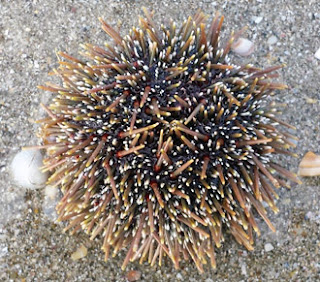I may of course be wrong on this, and of course dramatic tension would be pretty much destroyed if such delays had to be woven into the plot, but it got me thinking that there are some huge fundamental errors propagated in non-scientific circles. Therefore my Christmas/Hanukkah/holiday season present is a very brief, easy -on-the-brain round-up of a few of the more obvious examples.
- The Earth is perfect sphere.
Nope, technically I think the term is 'oblate spheroid'. Basically, a planet's spin squashes the mass so that the polar diameter is less than the equatorial diameter. Earth is only about 0.3% flatter in polar axis but if you look at a photograph of Saturn you can see a very obvious squashing. - Continental drift is the same thing as plate-tectonics.
As a child I often read that these two were interchangeable, but this is not so. The former is the hypothesis that landmasses have moved over time whilst the latter is the mechanism now accepted to account for this, with the Earth's crust floating over the liquid mantle in large segments or plates.
Geologist Alfred Wegener suggested the former in 1912 but is was largely pooh-poohed until the latter was discovered by ocean floor spreading half a century later. As Carl Sagan often said, "extraordinary claims require extraordinary evidence". - A local increase in cold, wet weather proves that global warming is a fallacy.
Unfortunately, chaose theory shows that even the minutest of initial changes can cause major differences of outcome, hence weather forecasting being far from an exact science.
However, there is another evidence for the validity of this theory, fossil fuel lobbyists and religious fundamentalists aside. I haven't read anything to verify this, but off the top of my head I would suggest that if the warm water that currently travels north-east across the Atlantic from the Gulf of Mexico (and prevents north-western Europe from having cold Canadian eastern seaboard winters), then glacial meltwater may divert this warm, denser seawater. And then the Isles of Scilly off the Cornish coast may face as frosty a winter as the UK mainland! - Evolution and natural selection are the same thing.
Despite Charles Darwin's On the Origin of Species having been published in 1859, this mistake is as popular as ever. Evolution is simply the notion that a population within a parent species can slowly differentiate to become a daughter species, but until Darwin and Alfred Russel Wallace independently arrived at natural selection, there really wasn't a hypothesis for the mechanism.
This isn't to say that there weren't attempts to provide one, it's just that none of them fit the facts quite as well as the elegant simplicity of natural selection. Of course today's technology, from DNA analysis to CAT scans of fossils, provides a lot more evidence than was available in the mid-Nineteenth Century. Gregor Mendel's breeding programmes were the start of genetics research that led to the modern evolutionary synthesis that has natural selection at its core. - And finally…freefall vs zero gravity.
Even orbiting astronauts have been known to say that they are in zero gravity when they are most definitely not. The issue is due to the equivalence of gravity and acceleration, an idea which was worked on by luminaries such as Galileo, Newton and Einstein. If you find yourself in low Earth orbit - as all post-Apollo astronauts are - then clearly you are still bound by our planet's gravity.
After all, the Moon is approximately 1800 times further away from the Earth than the International Space Station (ISS), but it is kept in orbit by the Earth's pull (okay, so there is the combined Earth-Moon gravitational field, but I'm keeping this simple). By falling around the Earth at a certain speed, objects such as the ISS maintain a freefalling trajectory: too slow and the orbit would decay, causing the station to spiral inwards to a fiery end, whilst too fast would cause it to fly off into deep space.
You can experience freefall yourself via such delights as an out-of-control plummeting elevator or a trip in an arc-flying astronaut training aircraft A.K.A. 'Vomit Comet'. I'm not sure I'd recommend either! Confusingly, there's also microgravity and weightlessness, but as it is almost Christmas we'll save that for another day.








